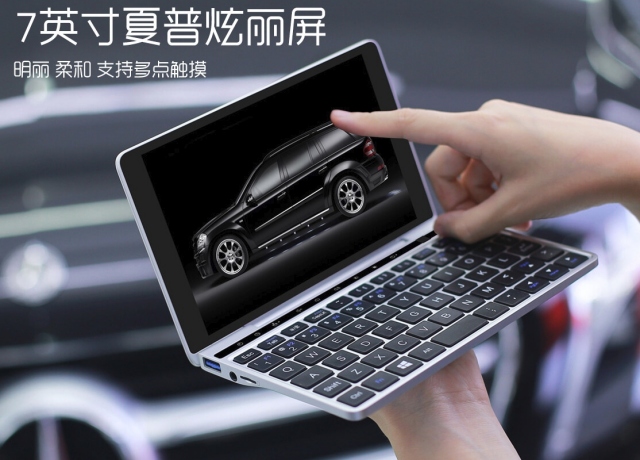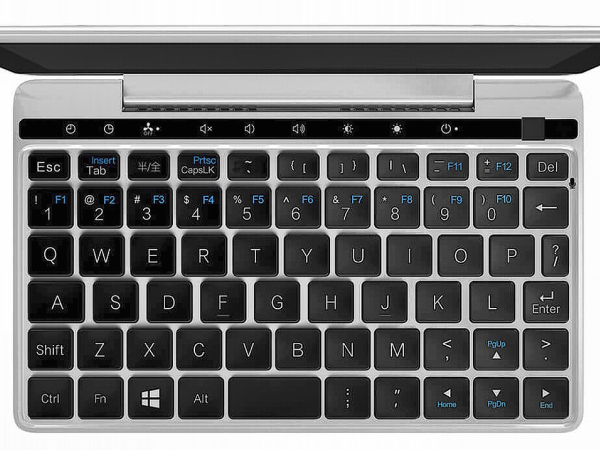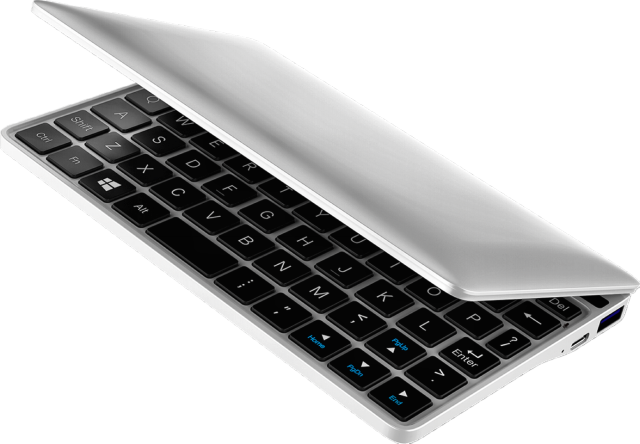
with articles on computer applications in photography.
|
The GPD Pocket 2 Leaner and meaner, but still just 128GB! |

|
Back to the Photo Bytes section, with articles on computer applications in photography. |
|
In July, 2018, Shenzhen Industries of Hong Kong announced the upcoming GPD Pocket 2 mini-laptop, a successor to the original Pocket, which I've been enjoying for the last year. In particular, I was recommending the Pocket as a photographer's companion, for off-loading images from memory cards, shooting tethered sessions, image management (including quick edits and raw development), documentation and other related tasks. It worked well in that capacity for me, and it looks like the new model would work even better.
| The IndiegogoGPD Pocket 2 crowd-funding campaign, launched late July, turned out to be yet another success, meeting the goal within just few hours. (Track record is the key!) The product, again, started shipping on time.. Update: units manufactured after January 10, 2019 use an upgraded processor: the Intel Core m3-8100Y instead of the original m3-7Y30. The article has ben updated to reflect that. Budget version: The Amber Black Edition uses a slower Celeron 3965Y processor and 4 or 8 GB of RAM, costing about $150 less. While the black model is pretty, I wouldn't feel comfortable recommending it.
| 
All promotional pictures © 2018 GPD Corporation
|
A quick comparison of the basic Pocket 2 specs with the original will give you some idea of what's new or improved (Pocket 2 shown in the 2019 version.)
First of all, the new processor more than doubles the performance seen in Pocket 1 at the expense of just 10% more power usage. Most impressive. For some users this may be enough of a reason to upgrade. A similar gain is claimed for the 3D graphics. The CPU benchmark results shown in the table do not tell the full story. They show the processor performance at the lowest nominal clock rate. The actual rate will usually be higher, cranked up until the temperature reaches a predefined limit. Therefore more power-efficient CPUs will usually run at a higher clock speed — a performance boost not reflected in fixed-rate benchmarks. This is why the current m3-8100Y seems to outrun the older m3-7Y30 (by 25% or so), in spite of benchmarking 3% lower.
For me, the solid-state drive is still the weakest spot. 128 GB is far from enough for almost any purpose. What may help here is the new MicroSD slot. If the card does not stick out from the socket, I could put there 400 or 512 GB and use it like an internal drive. Slower, but always. The eMMC storage is also quite slow. The new Pocket uses the same kind as the original, yet GPD claims double read/write speeds. If benchmarks actually confirm this claim, it would be good news.
|
Now, the new keyboard.
I had no problems with the quality of the Those issues have been addressed in Pocket 2. Gone are the split keys; the reduced-width ones (with a single exception) are now full-sized, too. The numeric and, importantly, arrow keys are now full-height. The space for that was gained by giving up the right Alt, Shift, and Control; at this keyboard size I find this perfectly acceptable. Mouse buttons have been moved from the bottom row to a separate strip at the top, with a mini pointer pad (far right), volume and brightness controls. A cooling fan switch is also there.
| 
|
I hope my hands-on experience will confirm this first impression, as GPD seems to have done a very nice and thoughtful redesign job here. The only thing I am really missing is backlit keys. I would gladly pay an extra $100 for that.
The new body shape. I really liked the brick shape of the "old" Pocket. It looked business-like, with cosmetics limited to just slightly rounded edges (which actually may make handling easier. No concessions to any fashion statements or "coolness factor".
|
The current fashion, however, asks for ultralight notebooks to be wedge-shaped, thickest at the hinge (or at least to pretend).
This is what GPD chose this time, tapering most of the body off near all three non-hinge edges, so when viewed from an angle above 30° or so it looks thinner than it actually is. For one person this is good looks, for another — just a waste of space. Not much of it, mind it: most of the body still has a uniform thickness — but a waste. Note that the right edge will now accommodate just one USB Type A and one Type C port. If not for the fashion police, this could be doubled (assuming the internals would allow that), or used for a slightly bigger battery, or just to improve air circulation (further gain in performance!).
| 
|
The new Pocket comes with Windows 10 Home Edition — no Linux version this time, but some Linux distros are a breeze to install.
This is not a typical Windows machine, however: it uses a high-resolution screen of a small physical size; some fonts in some applications may be too small to be readable. Font size adjustment in Windows never worked quite right. Be prepared for some irritating surprises. I also hope the new custom version of BIOS will be more polished, especially regarding battery status and charging. We will see. Pricing. Currently you can pre-order your Pocket 2 (8 GB RAM) at Indiegogo at $600. After the release, that will become $840. In many countries (including the EU) be prepared to pay up to 21% extra to the government as VAT. Tough. Is this too much? It may look like that to a U.S. expat, retired overseas on a fixed income. Still, this is not a mass-market product; R&D and design costs are not shared between millions of buyers; thus, I find these prices realistic and reasonable. Add, in addition to an immensely useful device, think of the bragging rights you acquire! The bottom line. This is a major upgrade of the original Pocket, with three really significant improvements: much faster CPU, greatly improved keyboard, and addition of a Micro-XD card. (There are two more things I would like to add: more CCD and backlit keyboard.)
The Competition. The One Mix Yoga 2S by One Netbook looks like a copycat model — the same size, style and form factor, similar keyboard, the same m3-8100Y CPU (both models switched from the m3-7Y30), and almost identical specifications, with one notable exception: the solid-state drive is of the faster PCI-E type and it can range from 128 to 512 GB (the 512 GB Koi Edition, up-in-your-face red, sells at US $880-1000 plus taxes, fees, and shipping). Add to that tablet mode (a fairly thick one, but always) and a touch screen with pen support and you get a very attractive package. On paper, at least. I'm still unsure which of the two companies is going to get my money. These are the few related articles or videos I was able to find on the Web:
Unfortunately, I wasn't able to find any detailed references to the 2019 update. | ||||||||||||||||||||||||||||||||||||||||||||

|
Back to the Photo Bytes section, with articles on computer applications in photography. |
| Home: wrotniak.net | Search this site | Change font size |
| Posted 2018/08/17, last updated 2019/04/08 | Copyright © 2017 by J. Andrzej Wrotniak |